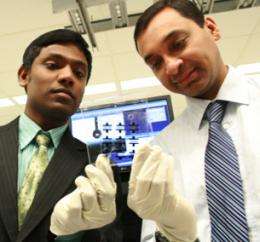Radical research changes lab-on-a-chip design

(PhysOrg.com) -- A University of Alberta mechanical engineering professor has developed a new model that could revolutionize the design of hand-held devices that provide reliable, nearly instant medical or environmental tests.
"Lab-on-a-chip" technology has resulted in the development of new devices capable of testing samples of everything from water to blood. As the size of these devices decreases, designers have struggled to find reliable way to control fluid flow through microchannels, which are integral part of the technology.
Now, professor Sushanta Mitra and PhD student Prashant Waghmare have published research findings, which appear as a featured article in the March issue of the scientific journal Analytica Chemica Acta, that address the problem. In order to use the technology to analyze fluids such as blood, the fluid sample is stored in a tiny reservoir on a glass chip and transported through a microchannel to a detection site, where the sample is typically detected and analyzed.
But getting the fluid from one reservoir to another can be challenging. Sometimes, physical forces known as capillary action are not adequate to move fluid through these tiny channels and if the sample is transported too quickly or too slowly, the analysis is inaccurate. In such situations, designers have placed electrodes beneath the microchannels and have tried to manipulate the transport of fluid using electrical fields.
Until now it has been an either-or situation, with chips being designed using capillary action or electroosmosis.
The model Mitra and Waghmare have developed takes both methods into account and represents a radical shift in microfluidic chip design. The pair has introduced a new non-dimensional number, which describes the interplay between capillary force and electroosmotism, to help design highly efficient chips that make the most of both effects.
"We are now able to control the flow by suitably manipulating the capillary action and the electric field, rather than designing chips by trial and error, which can be expensive and time consuming," said Mitra.
The design, Mitra says, could lead to devices that test for virtually anything.
For example, people at risk of heart attacks could be given hand-held devices to test their own blood for elevated levels of myoglobin, a protein which floods the circulatory system in the minutes leading up to a heart attack. With the prick of a finger, patients feeling unwell would be able to tests their myoglobin levels and call for help if necessary.
Provided by University of Alberta



















